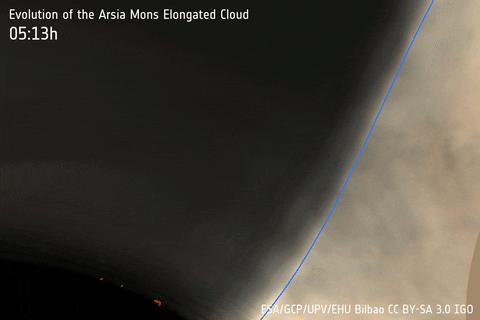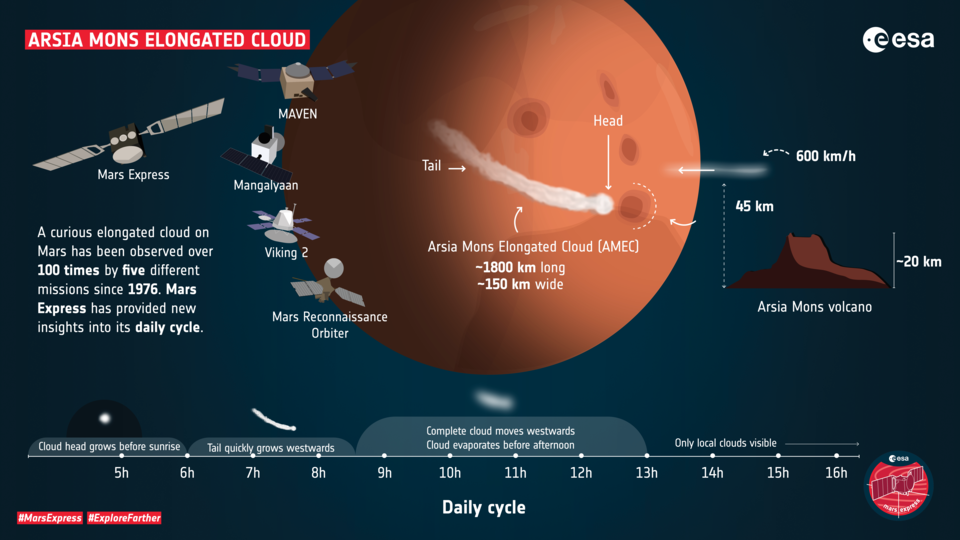9.03.2021

When spring arrives in southern Mars, a cloud of water ice emerges near the 20-kilometre-tall Arsia Mons volcano, rapidly stretching out for many hundreds of kilometres before fading away in mere hours. A detailed long-term study now reveals the secrets of this elongated cloud, using exciting new observations from the ‘Mars Webcam’ on ESA’s Mars Express.
Mars Express has spied this cloud before as it hovers near the Arsia Mons volcano, just south of Mars’ equator. Puzzlingly, Arsia Mons is the only low-latitude location on Mars where clouds are seen – and the only one of numerous similar volcanoes in the region to possess such a veil of cloud – at this time of year. Mars Express has seen this veil grow and fade on a daily basis throughout the spring and summer seasons, sending back striking images of this long and dramatic white cloud.
However, the cloud is difficult to observe in its entirety due to the fast, changeable dynamics of the martian atmosphere and the constraints of many spacecraft orbits, limiting our knowledge of how and why it forms and changes over time.

“To clear these hurdles, we used one of Mars Express’ secret tools – the Visual Monitoring Camera, or VMC,” says Jorge Hernández Bernal of the University of the Basque Country in Bilbao, Spain, lead author of the new findings and part of a long-term project studying the cloud’s dynamics.
Jorge and colleagues’ work demonstrates an exciting, and unintended, use for the VMC. Also nicknamed the Mars Webcam, the VMC has a resolution similar to that of a standard 2003 computer webcam. It was installed to visually confirm that the Beagle 2 lander had successfully separated from Mars Express back in 2003 – after which it was switched off. Several years later, the camera was reactivated and used to gather images of Mars for public engagement and outreach activities, but remained unused for scientific research.
“However, recently, the VMC was reclassified as a camera for science,” adds Jorge. “Although it has a low spatial resolution, it has a wide field of view – essential to see the big picture at different local times of day – and is wonderful for tracking a feature’s evolution over both a long period of time and in small time steps. As a result, we could study the whole cloud across numerous life cycles.”
The research team combined the VMC observations with those from two other Mars Express instruments – OMEGA and HRSC – and from several other spacecraft, namely NASA’s Mars Atmosphere and Volatile Evolution (MAVEN), Mars Reconnaissance Orbiter (MRO), and Viking 2 missions, and the Indian Space Research Organisation’s Mars Orbiter Mission (MOM). “We were especially excited when we dug into Viking 2’s observations from the 1970s,” says Jorge. “We found that this huge, fascinating cloud had already been partially imaged that long ago – and now we’re exploring it in detail.”

The findings revealed that, at its largest, the cloud measures some 1 800 km in length and 150 km across. It is the biggest ‘orographic’ cloud ever seen on Mars, meaning that it forms as a result of wind being forced upwards by topographic features (such as mountains or volcanoes) on a planetary surface. In this case, Arsia Mons perturbs the martian atmosphere to trigger the formation of the cloud; moist air is then driven up the flanks of the volcano in updrafts, later condensing at higher, and far cooler, altitudes.
The cloud undergoes a rapid daily cycle that repeats every morning for several months. It begins growing before sunrise on the western slope of Arsia Mons before expanding westwards for two and a half hours, growing remarkably fast – at over 600 km/h – at an altitude of 45 km. It then stops expanding, detaches from its initial location, and is pulled further westwards still by high-altitude winds, before evaporating in the late morning as air temperatures increase with the rising Sun.
“Many Mars orbiters cannot begin observing this part of the surface until the afternoon due to the properties of their orbits, so this really is the first detailed exploration of this interesting feature – and it’s made possible by not only Mars Express’ diverse suite of instruments, but also its orbit,” explains co-author Agustin Sánchez-Lavega, also of the University of the Basque Country and Science Lead for the VMC.
No other climate system in the Solar System is thought to be as similar to Earth’s as the martian system – but even still, the two planets show distinct and intriguing differences. “Although orographic clouds are commonly observed on Earth, they don’t reach such enormous lengths or show such vivid dynamics,” says Agustin. “Understanding this cloud gives us the exciting opportunity to try to replicate the cloud’s formation with models – models that will improve our knowledge of climatic systems on both Mars and Earth.”
As well as using the VMC in an exciting way, Jorge, Agustin and colleagues also overcame a typical challenge when observing transient phenomena on Mars. High-resolution cameras such as Mars Express’ HRSC have narrow fields of view, and observations are always planned in advance. As a result, meteorological phenomena – which are generally unpredictable – are usually caught by chance. However, once the researchers began to understand the life cycle and annual patterns of this elongated cloud, they were able to direct the HRSC team to the right place and right time to capture it as it emerged.
“These findings really demonstrate the strengths of Mars Express – its unique orbit, longevity, persistent quality, and ability to adapt as it tackles the mysteries of Mars,” says ESA’s Mars Express project scientist Dmitrij Titov.
“Repurposing the VMC has successfully enabled us to understand this transient cloud in a way that wouldn’t have been possible otherwise. The VMC allows scientists to track clouds, monitor dust storms, probe cloud and dust structures in the martian atmosphere, explore changes in the planet’s polar ice caps, and more. Its recommissioning not only supports Mars Express’ primary toolkit for Mars exploration, but adds new value to the long-standing mission, which has been revealing more about the Red Planet since 2003.”
Quelle: ESA
